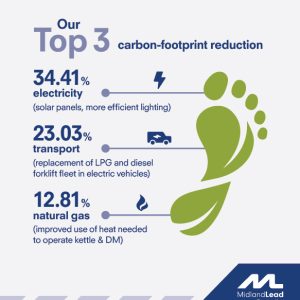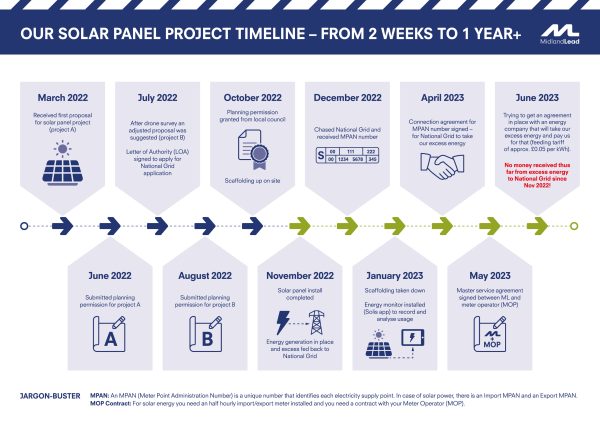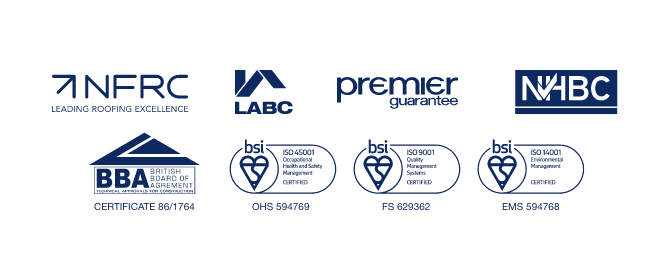What they don’t tell you about solar panel projects
Lessons learned at Midland Lead
Last year alone Midland Lead invested £230,000 in three projects that will reduce our carbon footprint as part of our ongoing commitment towards sustainable manufacturing.
One of those projects included the installation of 569 solar panels across a 1,102m2 area of our lead sheet manufacturing site in South Derbyshire. Although we’re very pleased with the estimated energy saving of 210,000 kWh per year from this investment, it has been a far longer and more complicated install than expected. That’s why we wanted to share our experience of the last eighteen months in the hope that you can learn something from our mistakes. Here’s our top-5 lessons learned:
1. Check if you need Planning Permission or not?
From the outset our solar panel installation company informed us that we needed planning permission. However, there were contradictions, and we have since learnt that we (possibly) didn’t need planning permission. As renewable energy is a relative new industry the official guidance is not clear and there is conflicting advice and a clear disconnect between installers, local authorities and government advice.
If planning permission is needed, your project will be delayed considerably. Our local council took 57 days to grant planning permission for our first proposal. But once we had the go-ahead, due to access issues, we changed the location of the solar panel project and needed to re-apply for permission – delaying the project by a further two months.
2. Make sure you have a clear timeline agreed
When planning and preparing for the installation, we were expecting the install project to take two weeks from start to finish – erecting the scaffolding, placing the panels etc. But in our case the delay started with the (un)availability of the scaffolders. Scaffolds went up in October 2022, install finished in November, but scaffolds only came down in January 2023.
Further delays occurred around the install of an energy monitoring system. We expected our solar partner to organize the excess energy we would generate over the weekends, to be fed back to the National Grid. Arrangements around this were unclear and we still [June 2023] are not paid for the excess energy supplied to the grid. So learn from our mistake, and make sure you have a clear understanding of who’s doing what & when.
3. Do your own Health & Safety and compliance checks
Working on a large solar panel install project, often involves working with subcontractors, and we hadn’t envisaged to be managing the subcontractors on site as much as we did. Due to the potential risks of placing solar roof panels, our team have spent quite some time ensuring we carried out compliance checks and H&S measures to keep everyone safe on site. So before you appoint your install partner, make sure you also check their compliance and H&S records and discuss responsibilities.
4. Think carefully where best to locate your solar panels
For large sites (ours is 13 acres in total) it is important to consider all aspects when choosing the best location for solar panels. Originally our panel location was based on our most energy-intensive manufacturing area (the smelting kettles). After a structural & drone survey, it was decided that another area of our site (cutting lines) was more suitable, due to easy access, maintenance and lower install costs. However, we forgot to consider the operating time in the area (which is shorter) and issues around excess energy.
So, when choosing your solar location, consider different angles, such as for example, access and maintenance, excess energy requirements, safety considerations, planning consequences, structural suitability and solar generation.
5. Get organized early to ensure you have energy monitoring and surplus energy agreements in place.
It is likely that you don’t immediately get paid for excess energy that you generate on site which is fed back into the grid. For us this was a real surprise and a lengthy process that we should have started at the beginning of this project. While our solar panels were installed in November and generated energy for our site, we weren’t able to monitor our use and our excess capacity until January. The additional work of getting paid for the energy we feed into the national grid is still ongoing [June 2023].
Make sure to apply for an MPAN (electricity supply number) that allows your system to be identified when feeding back into the main electricity supply chain. This then assigns an amount of p/kWh for energy generated back to your account. On top of this you need a connection agreement with the energy supplier and a further agreement with a meter operator to notify your energy provider that you have surplus power. At Midland Lead, this process is still ongoing…
Conclusion
Sustainable manufacturing is key for us here at Midland Lead, and although the process of our first solar panel project hasn’t been as straightforward as we expected, we are glad we did it and we are planning to install more panels in the near future. So don’t let us put you off, but make sure you learn from our mistakes. Our most important tips are:
- Carefully plan the project with an experienced installation company;
- Survey and understand your site and energy requirements;
- Explore the requirements around solar projects and planning permissions;
- Don’t underestimate the project timeline and allow for contingencies;
- Plan your internal resources carefully and ensure you have someone within your organisation who can help to project manage from start to finish;
- Do your due diligence on any sub-contractors and be clear on what your contractors carry out themselves and what they outsource;
- Understand the whole system as much as possible – from site surveys to getting energy contracts and MPAN numbers in place.
Most of all though, if sustainability is important for your organisation, then pursue solar panels if you can. Our investment in the project has an estimated pay-back period of 2.5 to 3 years, so a win-win situation in terms of cost-saving and sustainability.
If you have any questions, or would like to share your lessons learned with our business community and would like to add to our Top 5, please get in touch with us: markw@midlandlead.co.uk and/or francoise.derksen@midlandlead.co.uk.
PS: just a brief overview of the project on our YouTube channel: https://youtu.be/z-Mf9KD7CUY



